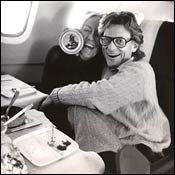
All of these men, they had an individuality that they never veered from. They were pure. That clearly was a generational privilege—they were allowed to understand the commercial, but they were never overly influenced by it; today, those two worlds have merged. They were great visionaries, all of them.
“Before I get to Helmut … you have to know that I’ve been boy-crazy all my life. Early in my career, I fell in love with a married man and had an affair for a little more than ten years. It was a huge scandal, but what can I tell you? I had never really been kissed before, and I went from his kiss to his bed, and because of it I learned how to let go.
“I worked with Helmut Newton at Vogue in the seventies. To work with him was a complete head trip. [Vogue creative director] Alex Liberman would say, ‘Don’t you think this is a Helmut shoot?’ Helmut would come in and we’d all talk about it, and then I would be alone with Helmut and we would take it so much farther.
“He aroused me—we did not have a physical relationship, except that maybe we did. I mean, nothing happened, but he opened my mind. It’s letting go, and not everyone could do that, you see, but I had been there. But at the same time, he had a certain reticence because he was extremely in love with his wife, and she was always with him.
“He came from a very good family, and he was German. It’s a kind of discipline, and it was the way he looked at women. When he was a very young man, he was a gigolo. It influenced his picture-taking. He loved Aryan women: the blonde, strong Amazon with waxy red lips. To me, there is no vulgarity in a Helmut Newton picture. People will argue with you. But that just makes me look harder at the person who’s critical.
“My friendship with Richard Avedon started in 1951 at Harper’s Bazaar. When he met me, he said, ‘I really don’t want to work with her; she’s too noisy.’ [Then-editor] Diana Vreeland talked him into it. We did this shoot and it was Audrey Hepburn, and she was absolutely adorable and I didn’t say a word. But we became the best of friends.
“I didn’t work from 1952 to 1963. I got married and lived on the Main Line in Philadelphia and had two children. I learned to play golf. I wanted to be with my children during those really formative years. But it was a turbulent marriage. My husband turned out to be a homosexual. I was too strong for him, I guess, and he fell in love with a beautiful young man. I think he really loved me, but he knew I wasn’t in love with him.
“And then Mrs. Vreeland said, ‘Come back.’ She was at Vogue by then. The first sitting I did was five weeks in the Orient with Dick. Can you imagine? I didn’t have a friend at Vogue, and I said, ‘Mrs. Vreeland, I just feel like I’ve alienated everybody,’ and she said, ‘Polly, who needs friends? Get on with it.’
“There was never anything physical between Dick and me; however, it was a love affair. “Photography had become rather stilted; he brought a reality, a beauty, a sense of movement. For me, he was the most exciting, important photographer working and remained that until his death. “I wanted to do this picture with a Rei Kawakubo body stocking, where she pulls up her dress and shows that area and just stands there. And Dick said, ‘Why do you want to do that?’ I said, ‘Young women are going through a terrible time right now, what with the Pill and men, and there’s a fixation on youth,’ and he said, ‘Okay, but who will do that?’ I said, ‘Stephanie Seymour.’
“Stephanie was sort of in love with Dick. Very much so. You know, Dick was very easy to be in love with. That does not mean they were having an affair. Intercourse. Fucking. It does mean that he was a charmer for certain women. Not for others.
“Helmut and Dick, we’re talking about men. Now we’re really going to talk about women. Francesco Scavullo had so much woman in him! Scavullo was a lovely person, but he believed in beauty and he was uncomfortable going farther than that.
“Now, Joe [Eula] is an interesting thing. He did wonderful things for Halston. He was multifaceted, and sometimes when you are, it’s hard. He could design fabric, he could throw pots, he could do a quick sketch. And then he was a great cook!
“Geoffrey Beene gave a tremendous sense of style to American fashion. His clothes were beautiful and minimal, and they were all about line. He was a modernist in its truest sense. He was always experimenting with fabrics and with cut. I think all fashion designers look to his collections when they start, but he never really captured the young; he never was watching the street. But he was such a great talent—his gardens were extraordinary. How to describe this very important designer? God, he was really the big time.”